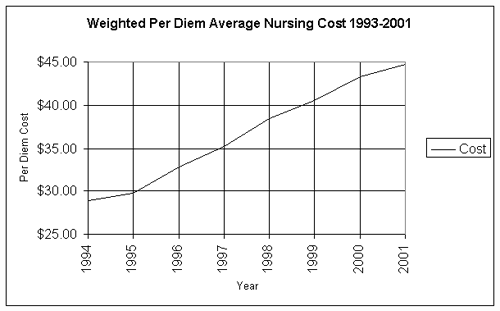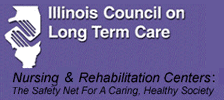|

April 24, 2001
Direct Care Drives Nursing Home Cost Increases;
Medicaid Reimbursement Falls Far Behind
(CHICAGO) -- Medicaid rates paid to nursing homes have
increased 29% since 1994. But, operational costs have
increased 51% during the same period. Nursing and medical
costs -- costs related directly to the care of the residents
-- have increased 65%, the fastest rising sector of
nursing home operational costs. These nursing and medical
costs, consisting of nursing staffing and medical supply
costs, comprise 49.5 % of an Illinois nursing facility's
total operational costs.
It has become increasingly expensive to attract and
retain quality nursing staff in today's highly competitive
labor market. There is a dire shortage of nurses plaguing
our state's health care system, leading to dramatic
increases in nurse salary levels.
Nursing home residents require more skilled nursing
than ever before. Those elderly who are more healthy
and independent are discovering more health care options
available to them, including home health care and assisted
living. Today, persons entering nursing homes are more
clinically complex, with a multitude of specialized
care requirements. Their needs for more medical attention,
increased nursing care, and advanced treatments have
forced nursing costs to grow by leaps and bounds.
In 1997, the federal government cut Medicare payments
to the point where many nursing facilities lost large
amounts of money on Medicare patients. Hundreds of nursing
homes across the country declared bankruptcy, including
over 12% in Illinois. A similar situation is now happening
with our Medicaid system, with reimbursement not reflecting
our state's rising nursing costs.
With two-thirds of our state's nursing home residents
dependent on Medicaid, it is important that the state
provides adequate funding to meet their needs. Two pieces
of proposed state legislation are designed to rectify
our state's Medicaid funding disparity.
Senate Bill 608 requires the State to calculate Medicaid
rates based on current costs and wages, using the 1999
cost reports, and not those from 1992. Similarly, House
Bill 3538 requires basing Medicaid rates on 1999 cost
reports but, additionally, requires that the Medicaid
rate be also based upon current resident assessments,
and not assessments completed in 1993.
"Both Senate Bill 608 and House Bill 3538 restore
the Illinois safety net for some of our most frail and
vulnerable citizens," states Terrence Sullivan,
executive director of the Illinois Council on Long Term
Care.
The coalition that supports these two pieces of legislation
is made up of the state’s four largest professional
nursing home associations – the Illinois Council on
Long Term Care, Illinois Health Care Association, Life
Services Network of Illinois and the County Nursing
Home Association –
as well as the state’s largest nursing home employee
union – the Service Employees International Union, Local
#4. Together they represent more than 54,000 professionals
and caregivers serving
73,000 nursing home residents. The Catholic Conference,
Community Bankers Association and Metro Counties Association
also support these pieces of legislation.

Editor’s note: Original and digital versions of this
chart are available for publication.
|

